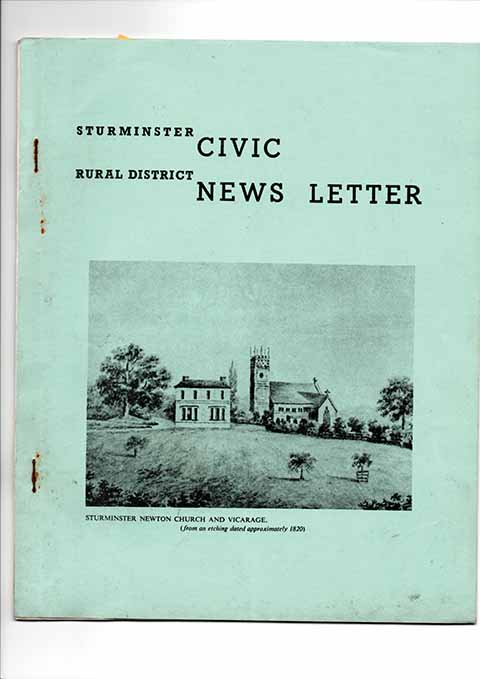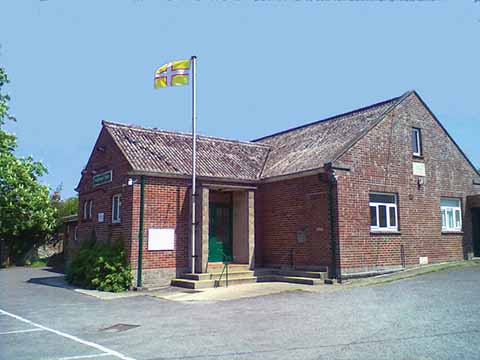Windows on the 1950s
Roger Guttridge on a collection of council newsletters shedding light on life in Sturminster Newton's Rural District more than sixty years ago
Published in September ’19

The first ERNIE became a hot topic in 1956 when the Stur RDC News Letter reported on the local launch of Premium Bonds
It was a decade that gave us rock ’n’ roll, the Suez crisis and the first female monarch since Queen Victoria. It was also an era when things like the television set and the family car came into their own as possessions that every family aspired to. And in Dorset, such everyday advances are reflected in copies of the Sturminster Rural District Civic News Letter, which have come to light after 60 years. In fact, both motor cars and the growing forest of TV aerials were among the topics exercising the minds of Dorset’s civic leaders in the 1950s.
‘The County Planning Committee have considered the unsatisfactory conditions which are arising from the number of TV aerials on housing estates etc and urge consideration of the provision of master aerials,’ says a paragraph in the February 1957 issue of the News Letter. ‘The Committee feel that an investigation should be made as to the possibility of introducing a master aerial for an estate as a pilot scheme and have given instructions for an estimate to be obtained in respect of Waterlake Estate, Stalbridge.’
In October 1956, the Civic News Letter reported that bus companies in Dorset were warning that the ‘increase in private motoring and the practice of giving lifts’ had seriously affected revenues from most village services. Among other things, rural transport was considered of the ‘utmost importance’ to the agricultural industry and a deputation had recently shared this view with the Ministry of Transport. Some novel solutions were initiated, including the licensing of a clergyman who wished to run a bus service to transport his flock to church. Villagers owning a Land Rover, a large car or a ‘small bus’ (maximum passengers 14) were encouraged to provide transport for their neighbours.
At Mappowder and Glanvilles Wootton, council tenants ‘from time to time’ requested garages for their cars. The RDC acknowledged that cars parked on highways and other ‘unsuitable areas’ in many towns and villages were a public nuisance but decided not to provide even temporary hard standings at that time.
The twelve Civic News Letters were saved by the Rev. Barrie Hirst, who was Sturminster Newton’s Methodist minister in the 1960s. Now 87 and living in Lincolnshire, he recently gave them to his friends, Richard and Margaret Cowell of Gillingham, with a request that they be returned to Sturminster. The Cowells plan to give them to Sturminster Museum, whose premises are pictured on two front covers. The News Letters cover the four years from 1956 to 1959 and open a window onto everyday life in 1950s Dorset. The editions range in length from 20 to 44 typewritten pages, each packed with information about day-to-day happenings in an era of change on many fronts.
One of national government’s more successful 1950s innovations was the Premium Bond, which was designed to control inflation and encourage saving in the post-war era. The first draw was in November 1956 with a maximum investment of £500 and a top prize of £1,000. The equivalent figures today are £50,000 and £1 million.
Within three years, the district had a savings total of almost £1.5 million, of which £11,102 was in Premium Bonds. In Dorset as a whole, 904 prizes totalling more than £40,000 were won during the first 18 months alone.
Other 1956 innovations at Sturminster included street nameplates and evening classes. Sturminster Parish Council asked the RDC to erect nameplates, and the News Letter commented: ‘It would be of interest to hear whether any other parish desires to see their streets adequately named, or whether they would regard such provision as another step towards the urbanisation of the countryside.’
At the old Secondary Modern School in Penny Street, Headmaster Stan Tozer had started an experiment that was being ‘watched with very great interest’. ‘He has,’ said the News Letter, ‘introduced an Evening Institute on the lines with which he was associated in his previous county of Essex. So far it seems to have been a great success, and one can only wish Mr Tozer well, and that his venture grows in strength. It does at least offer adequate opportunity for the useful employment of youth during evening hours.’
Mr Tozer’s scheme was an unqualified success. By the time the Evening Institute opened for its third year in September 1958, subjects available to adults and youth members included woodwork (junior and adult), cookery, shorthand & typing, art & craft, dressmaking, ballroom dancing, ladies’ keep fit, film group, a modern approach to Bible studies and the UEI exam course, which comprised maths, English and technical drawing.
At Shillingstone, a village hall was ‘now within sight’ following the laying of the foundation stone in October 1956 by Mrs C B Portman. She was later revealed as the ‘fairy godmother’ whose ‘generous donation’ had met much of the hall’s cost. Shillingstone was later described as ‘one of the best equipped parishes within the district’, having not only a new village hall but hard surface tennis courts, also paid for by Mrs Portman, and a ‘delightful’ recreation ground. The hall, designed by architect Mr E E G Bartlett and built by Hammond and Sons of Sturminster Newton, cost £7,600 of which Mrs Portman donated £5,000. It’s easy to understand why, 63 years later, the building is still known as the Portman Hall.
Shillingstone’s very name was under the spotlight in 1957. Both the district and parish councils wanted this particular member of the ‘three Okefords’ to be called ‘Shilling Okeford’, and the county council’s insistence on ‘Shillingstone’ was ‘noted with regret’.
Domestic refuse collection was said to be a constant source of ‘complaint and irritation’, partly because the district-wide service had evolved organically from the days when it was a parish rather than a district responsibility. In those days, only Sturminster Newton had a weekly collection. Rubbish at Stalbridge and Marnhull was collected monthly, at Child Okeford, Stourton Caundle and Okeford Fitzpaine quarterly and at Glanvilles Wootton twice a year. No other parish had any collection at all.
At Hinton St Mary, there were complaints about muddy roads. The Rivers Estate wrote to tenants, calling for an improvement, and the two farmers mostly responsible had promised to ‘clean up some of the mud’.
Dorset Police celebrated their centenary in 1956 with a parade at Dorchester and an exhibition at County Hall. When the County and Borough Police Act was passed in 1856, compelling every county to establish a properly organised police force, Dorset already had a force covering the Sturminster, Shaftesbury and Wimborne petty sessional divisions, and these formed the nucleus of the combined force.
The small borough forces at Bridport, Lyme Regis and Shaftesbury amalgamated with the county in 1873, Wareham in 1887, Blandford and Dorchester in 1890 and Poole’s paid force in 1891. Weymouth waited until 1921 before joining the county-wide force.
The News Letter featured stories on various parish churches around the district, contributions by or about long-serving councillors, written discussions about proposals for local government re-organisation and brief news items on events ranging from repairs to the ancient stone cross at Stalbridge to plans for the opening of Sturminster’s new Secondary Modern School in Bath Road.
In October 1958, archaeologist Professor Ian A Richmond reported on the results of seven years of excavations at Hod Hill, which had just come to an end, of which more in November’s Dorset Life.



